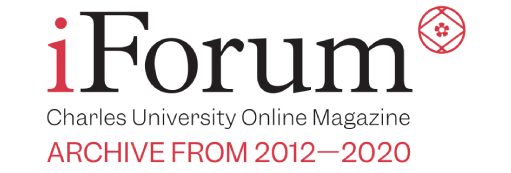Georgia Moss • foto: Archive Press department • 15 February 2018
New Mace and Ceremonial Gown of the Faculty of Social Sciences Exhibition
Charles University is an institution steeped in history; as the oldest University in Central Europe founded in 1348, its own past is closely interlinked with important historic shifts in the Czech Republic and wider Europe.
The New Mace and Ceremonial Gown exhibit held from the 19th January until 20th February 2018 in the Cloister of the Karolinum, the central point of Charles University nestled in the centre of Prague, showcased the Faculty of Social Sciences new ceremonial mace and gown. The ceremonial mace plays an important role in the graduation and matriculation of Charles University students; students lay their fingers on the mace to honour their commitment and loyalty to the University. The design of each faculty’s mace is symbolic of subject it represents; demonstrated through the Faculty of Arts mace created in 1882 including an owl and the sun, representative of wisdom and truth respectively. Whilst the mace of the Faculty of Mathematics and Physics, designed in 1979, consists of metal rods of geometric shapes with orbiting planets in the centre, and in the crown, a Mobius strip to symbolise the never-ending knowledge presented through Mathematics and Physics.
The Faculty of Social Science is one of Charles University’s newer faculties, as it was founded in 1990, and this new mace was sculpted by Otmar Oliva, whose previous work is exhibited for example in the St. Pope John Paul II Chapel in the Vatican. As with the maces of other faculties, the design is symbolic of the feats and facets of the Social Sciences, the motif of an open hand is used to represent human society in the palm of the hand, with each finger representing the fields developed in the faculty (Geography, Economics, Government, Culture and History). The mace is themed around ‘Society in the Palm of our Hand’, a concept penned by Prof. Martin Potůček, whilst the style of the design of the mace mirrors the gold gilded older designs from the 19th century. The exhibition contains a photo series taken by Sandra Štefániková and Filip Lába, chronicling the step by step process by which the mace was manufactured. Further detailing of the process of design and creation can be found in the book ‘Přísahejme na vlastní’ (Let's Swear on Our Own).
 The exhibition also showcases the uniquely designed ceremonial gown, its grandeur similar to that of the mace, with deep blue material, golden embroidery and buttons alongside a red over-robe. The gown was designed by Charles University graduate Alena Zvolánková, who also studied at the Department of Clothing Technology at the Technical University of Liberec, and will like the mace be a part of future graduation and matriculation ceremonies for students of the Faculty of Social Sciences as it is worn by the faculty’s bedel.
The exhibition also showcases the uniquely designed ceremonial gown, its grandeur similar to that of the mace, with deep blue material, golden embroidery and buttons alongside a red over-robe. The gown was designed by Charles University graduate Alena Zvolánková, who also studied at the Department of Clothing Technology at the Technical University of Liberec, and will like the mace be a part of future graduation and matriculation ceremonies for students of the Faculty of Social Sciences as it is worn by the faculty’s bedel.
Below the Cloister is the permanent exhibition of the history of Charles University, held in the atmospheric and cavernous below ground cellars of the Karolinum. The historical artefacts and memorabilia displayed here act to further contextualise the importance of the new artefacts in the exhibition in the Cloister as extensions of Charles University’s past.
The maces, for example, hark back to a time in Charles University’s past when the University was split into the German and Czech halves; this occurred in 1882. Both parts had their own maces, with the maces of the Czech side being older and grander, while the ones displayed and utilised in Charles University today being those commissioned in the 1880s by the German University in Prague. Both sides of the university enjoyed prolific alumni and teachers (Franz Kafka, Albert Einstein and Ernst Mach on the German side and Czechoslovak first President Masaryk on the Czech or Czechoslovakian side), and growth in faculties and student enrolment. Upon the outbreak of the Second World War and the Nazi occupation of Czech lands, all Czech universities were shut down, and in 1945 following the war the German side of the University was abolished due to the removal of Germans from Czechoslovakia. However, the older maces of the Czech University and the original charter of the founding of Charles University by Charles IV in 1348 were taken by the Germans and never recovered, likely due to them either being lost or destroyed. Hence the reason why the University only owns a copy of the manuscript of the original founding charter and the 19th century maces are used ceremonially now at Charles University (next to those newer ones such as the exhibited mace of the Faculty of Social Sciences).
The exhibition provides valuable insight into the way that past traditions heavily influence the creation of new ceremonial items within the University today, as the new mace and gown aesthetically and symbolically reflect a homage and loyalty to the ritualised values of Charles University.
|
Georgia Moss is an Erasmus student from the UK studying at the Faculty of Humanities. At home she attends Durham University and studies Anthropology. |
